The Homer IPTs
No Reasonable Offer Refused
I hate sailing with a less than full boat. If you would like to make an offer on one or more of the Bald Eagle IPTs below, please click here.
IPT #1: MON 20 FEB 2023 through the full day on FRI 24 FEB 2023. Five full days/20 hours on the boat: $5500.00. Limit 5 photographers/Openings: 1.
IPT #2: SAT 25 FEB 2023 through the full day on THURS 2 MAR 2023. Six full days/24 hours on the boat: $6600.00. Limit 5 photographers/Openings: 3.
IPT #3: FRI 3 MAR 2023 through the full day on TUES 7 MAR 2023. Five full days/20 hours on the boat: $5500.00. Limit 5 photographers. Openings: 1.
What’s Up?
With my sore throat continuing but not getting worse, I skipped my swim again on Sunday. I called my accountant and asked him if he were sitting down. Then I told him that I had begun working on my 2022 taxes. I have not filed on time in several decades.
I created and sent SONY Alpha a1 Set-up and Info Group Notes e-Mail E. For the most part, it dealt with the new strategies I have come up with involving Tracking: Expand Spot.
An injured Patrick Mahomes (high ankle sprain) led the Kansas City Chiefs to the Super Bowl in two weeks with a nail-biting victory over the Joe Burrow-led Cincinnati Bengals. Previously, the Bengals had come from behind in three straight games to defeat KC. Mahomes and star tight end Travis Kelce celebrated after the game like little boys on Christmas morning. Here’s hoping that the Chiefs destroy the Philadelphia Eagles in Arizona in 13 days.
Of yesterday’s three images, I liked Image #1 best because of the dramatically angled wing position and the water being squeezed out of the bill pouch. #3 was my second choice.
Today is Monday 30 January 2023. I will continue to work on my 2022 taxes. This blog post took about 90 minutes to prepare (including the time spent on the three image optimizations) and makes three hundred-seven days in a row with a new, educational post. Wherever you are and whatever you are doing, I hope that you too have a great day.
Please, please, pretty please remember to use my B&H or Bedford’s affiliate programs for all your new gear purchases.
The plan is to continue to post every day until the streak reaches one year and one day and then go back to posting every other day.
Please remember to use the B&H and Amazon links that are found on most blog pages and to use the BIRDSASART discount code at checkout when purchasing your new gear from Bedfords to get 3% back on your credit card and enjoy free second-day air FedEx. Please, also, consider joining a BAA IPT. You will be amazed at how much you will learn!
You can find some great photo accessories (and necessities, like surf booties!) on Amazon by clicking on the Stuff tab on the orange/yellow menu bar above. On a related note, it would be extremely helpful if blog-folks who, like me, spend too much money on Amazon, would get in the habit of clicking on the Amazon logo link on the right side of each blog post when they shop online. As you might expect, doing so will not cost you a single penny, but would be appreciated tremendously by yours truly. And doing so, works seamlessly with your Amazon Prime account.
Please remember that if an item — a Delkin flash card, or a tripod head — for example, that is available from B&H and/or Bedfords, is also available in the BAA Online Store, it would be great, and greatly appreciated, if you would opt to purchase from us. We will match any price. Please remember also to use my B&H affiliate links or to earn 3% cash back at Bedfords by using the BIRDSASART discount code at checkout for your major gear purchases. Doing either often earns you free guides and/or discounts. And always earns my great appreciation.
|
|
|
This image was created on 28 April on a Spring 2022 Fort DeSoto Park IPT. Crouching down a bit, I used the handheld Sony FE 200-600mm f/5.6-6.3 G OSS lens (at 600mm) and The One, the Sony Alpha 1 Mirrorless digital camera. ) The exposure was determined using Zebra technology with ISO on the Thumb Dial. ISO 1000. 1/1600 second at f/6.3 (wide-open) in Manual Mode. AWB at 7:29:06am on a sunny morning. RawDigger showed the exposure to be perfect. Tracking: Zone AF-C with Bird Face/Eye Detection performed perfectly. Be sure to click on the image to enjoy a high-res version. Image #1: Ruddy Turnstone running on wet sand near the edge of the surf
|
The Sony 200-600 on Sunny Days
With its relatively slow f/6.3 aperture, the Sony 200-600 G zoom lens really shines on sunny days, allowing for the use of the relatively high shutter speeds in the range of from 1/1600 to 1/3200 sec. These shutter speeds are needed to create sharp photographs of running shorebirds and of flying pelicans, gulls, and terns without having to crank up the ISO.
Why Crouching?
Why was I crouching when I created each of today’s featured images when I could have gotten lower by sitting?
|
|
|
This image was also created on 28 April on a Spring 2022 Fort DeSoto Park IPT. Again, crouching down a bit, I used the handheld Sony FE 200-600mm f/5.6-6.3 G OSS lens (at 353mm) and The One, the Sony Alpha 1 Mirrorless digital camera. ) The exposure was determined using Zebra technology with ISO on the Thumb Dial. ISO 1000. 1/1600 second at f/6.3 (wide-open) in Manual Mode. AWB at 7:34:52am on a sunny morning. RawDigger showed the exposure to be perfect. Tracking: Zone AF-C with Bird Face/Eye Detection performed perfectly. Be sure to click on the image to enjoy a high-res version. Image #2: Willet running in shallow surf
|
Running Shorebird Backgrounds
In sweet early morning light, the wet sand along the edge of the surf and/or gently breaking wavelets provide some of my favorite beach backgrounds. Join one of the Spring 2023 DeSoto Instructional Photo-tours to learn the strategies that I employ to create running shorebird images. When conditions are perfect, it takes a lot more than luck to succeed. Many would not be surprised to learn that wind direction is one of the factors involved.
Sony FE 200-600mm f/5.6-6.3 G OSS Lens versus the Canon RF 100-500mm f/4.5-7.1 L IS USM Lens
Sorry. This one is pretty much no contest. Maximum reach? Sony. Speed at the long end? Sony. Smooth and efficient zooming? Sony, due for the most part to the 2-6’s internal focusing; the lens length remains constant as you zoom in an out. Zooming in and out with the RF 100-500 is stiff and clunky at best as the lens changes length during the process. This dramatically affects handling and ease of use. Price — amazingly, the 200-600 costs $701.00 less than the 100-500.
AF with either lens remains superb when a 1.4X teleconverter is added, but with Canon, you lose much of the short end of the zoom range: 420-700mm with the TC. With the Sony lens you are at 280-840mm.
Though the 200-600 focuses to a very impressive less than 8 feet at 600mm, the Minimum Focusing Distance battle goes to the RF 100-600 with its 2.95 feet MFD. And the 1-5 is more than 1 1/2 lbs. lighter: 3 lbs. vs. 4.65 lbs. While I am easily able to handhold the 200-600, others might struggle doing so.
Throw in the fact that the a1 is far superior to any of the Canon mirrorless camera bodies and it is obvious that the Sony 200-600 reigns supreme among the large mirrorless telephoto zoom lenses.
Just for the Record
If you are not using a Sony a1 for bird photography, you are making your life far more difficult than it needs to be. Period. If you would like to receive a short but frank e-mail explaining why the Sony a1 is so much better than the best Nikon and Canon mirrorless camera bodies, please click here.
|
|
|
This image was also created on 28 April on a Spring 2022 Fort DeSoto Park IPT. Again, crouching down a bit, I used the handheld Sony FE 200-600mm f/5.6-6.3 G OSS lens (at 353mm) and The One, the Sony Alpha 1 Mirrorless digital camera. ) The exposure was determined using Zebra technology with ISO on the Thumb Dial. ISO 1000. 1/2500 second at f/6.3 (wide-open) in Manual Mode. AWB at 7:41:30am on a sunny morning. RawDigger showed the exposure to be perfect. Tracking: Zone AF-C with Bird Face/Eye Detection performed perfectly. Be sure to click on the image to enjoy a high-res version. Image #3: Sanderling running along the edge of shallow surf
|
Your Call?
Which of today’s three featured images is your favorite? Please leave a comment letting us know why you made your choice.
Exposure Question
Why was the shutter speed for the Sanderling image (1/2500 second), 2/3-stop faster than the shutter speed for the turnstone and Willet images (1/1600 second)?
|
|
|
Fort DeSoto in spring is rife with tame birds, many in full breeding plumage. Click on the composite to enjoy a larger version. Clockwise from upper left around to center: Laughing Gull landing on head of Brown Pelican, Laughing Gull in flight, Reddish Egret sunrise silhouette, Great Blue Heron with needlefish, Yellow-crowned Night Heron with ghost crab, Roseate Spoonbill, Sanderling in breeding plumage, and white morph Reddish Egret in glorious breeding plumage. |
The 2023 Spring Fort DeSoto Instructional Photo Tours (IPTs)
Spring Fort DeSoto IPT #1: Tuesday 28 March through the morning session on 31 March 2023. 3 1/2 Days: $1899.00 includes three working brunches. Limit six photographers.
Spring Fort DeSoto IPT #2: Tuesday 11 April through the morning session on 14 April 2023. 3 1/2 Days: $1899.00 includes three working brunches. Limit six photographers.
Spring Fort DeSoto IPT #3: Tuesday 9 May through the morning session on 12 May 2023. 3 1/2 Days: $1899.00 includes three working brunches. Limit six photographers.
Fort DeSoto, located just south of St. Petersburg, FL, is a mecca for terns and gulls, wading birds, and shorebirds in spring. Many of the birds will be in full breeding plumage. Simply put, DeSoto is the new Ding Darling. Migrant shorebirds are in abundance, and many are exceedingly tame. We should have great chances on Royal and Sandwich Terns and both white- and dark-morph Reddish Egrets. Great Egret, Snowy Egret, Great Blue Heron, Tricolored Heron, and White Ibis are easy as well and we will almost surely come up with a tame Yellow-crowned Night-Heron or two along with some American Oystercatchers. We will enjoy lots of great flight photography, especially with the Brown Pelicans.
|
|
|
Again, Fort DeSoto in spring is rife with tame birds, most in breeding plumage. Click on the composite to enjoy a larger version. Clockwise from upper left around to center: Laughing Gull in flight, Yellow-crowned Night-Heron, Sandwich Terns copulating, Roseate Spoonbill, Great Egret with reflection, breeding plumage Short-billed Dowitcher, American Oystercatcher, Royal Tern, white morph Reddish Egret, and Snowy Egret in marsh. |
In Addition!
We should also get to photograph a variety of other shorebirds including Black-bellied, Semipalmated, Wilson’s, Snowy, and Piping Plovers, Willet, Dunlin, Short-billed Dowitcher, Marbled Godwit, and most especially, Red Knot, with many individuals in their handsome breeding plumages. In spring the T-shaped peninsula and the newly formed sandbar, Outback Key, are literally packed with avian treasures.
With just a bit of luck, we may get to photograph one of Florida’s most desirable species: Roseate Spoonbill. And we will surely get to do some Brown Pelican flight photography. With luck, they will have Laughing Gulls landing on their heads. And though not guaranteed, Wood Stork might well be expected. And we will be on the lookout for a migrant passerine fallout in the event of a thunderstorm or two.
|
|
|
Yes, Fort DeSoto in spring is rife with tame birds, most in breeding plumage. Click on the composite to enjoy a larger version. Clockwise from upper left around to center: breeding plumage Dunlin, dark morph Reddish Egret displaying, Laughing Gull vertical front-end portrait, Laughing Gull with prey item, landing on head of Brown Pelican, breeding plumage Royal Tern displaying, Royal Terns — pre-copulatory stance, Laughing Gulls copulating, Laughing Gull head portrait, breeding plumage Sandwich Tern with fish, and a rare treat, a breeding plumage White-rumped Sandpiper. |
What You Will Learn on a DeSoto IPT
- 1- The basics and fine points of digital exposure; how to get the right exposure every time after making a single test exposure (or before if you are using SONY gear).
- 2- How and why to work in Manual mode (even if you’re scared of it).
- 3- How to approach free and wild birds without disturbing them.
- 4- Lots about bird behavior and how to use that knowledge to help you create better images.
- 5- To age and identify many species of shorebirds including various sandpipers, plovers, dowitchers, and possibly yellowlegs.
- 6- To spot good situations and to choose the best perspective.
- 7- To see, evaluate, and understand the light.
- 8- To design pleasing images by mastering your camera’s AF system.
- 9- And perhaps most importantly, to evaluate wind and sky conditions and understand how they affect bird photography.
- 10- More than you could ever imagine.
|
|
|
You’ve got it by now! Fort DeSoto in spring is rife with tame birds, many in breeding plumage. Click on the composite to enjoy a larger version. Clockwise from upper left around to center: Roseate Spoonbill, immature Brown Pelican in flight, the heron/egret hybrid, American Oystercatcher feeding, immature Royal Tern on railing, Great Egret morning silhouette, Black Skimmer in surf, and underside head portrait of Great Blue Heron. |
The Details
Morning sessions will run two and one-half to three hours; afternoon sessions about two. There is never a set schedule on an IPT — we adapt to the conditions. On cloudy mornings with the right wind, we may opt to photograph till noon and skip the afternoon session. That especially when the afternoon weather is looking iffy. We may opt to visit a great North Tampa rookery if conditions warrant that.
There will be a Photoshop/Image Review session before and after brunch (included) each of the three full days. That will be followed by Instructor Nap Time. Each of these IPTs will run with only a single registrant as I do not like disappointing anyone. The best airport is Tampa (TPA). Once you register, you will receive an e-mail with lodging information. Do know that it is always best if IPT folks stay in the same general area (rather than at home or at a friend’s place a good distance away).
Folks attending this IPT will be out in the field as early as possible and stay out late to take advantage of sunrise and sunset colors; this is pretty much a staple on almost all BIRDS AS ART Instructional Photo-Tours. Doing so will often present unique photographic opportunities, opportunities that will be missed by those who need their beauty rest and those who need to get home for a proper dinner. I really love it when I am leaving the beach at 9:30am on a sunny morning after a great session just as a carful or two of well-rested photographers are arriving … We will be getting wet.
Your $599 deposit is due now. Credit cards are OK for that. You can register by calling Jim or Jennifer during weekday business hours at 863-692-0906 with a credit card in hand. Once you leave a deposit, you will receive an e-mail with your balance statement and instructions for sending your balance check three months before the trip begins. If you wish to pay in full right off the bat, you can make your check out to BIRDS AS ART and send it via US mail here: BIRDS AS ART, PO BOX 7245, Indian Lake Estates, FL 33855. You will receive a confirmation e-mail with detailed instructions, and clothing and gear advice two months before the trip. Please shoot me an e-mail if you plan to register or if you have any questions.
IPT veterans and couples or friends signing up together may e-mail for discount information.
Typos
With all blog posts, feel free to e-mail or to leave a comment regarding any typos or errors.

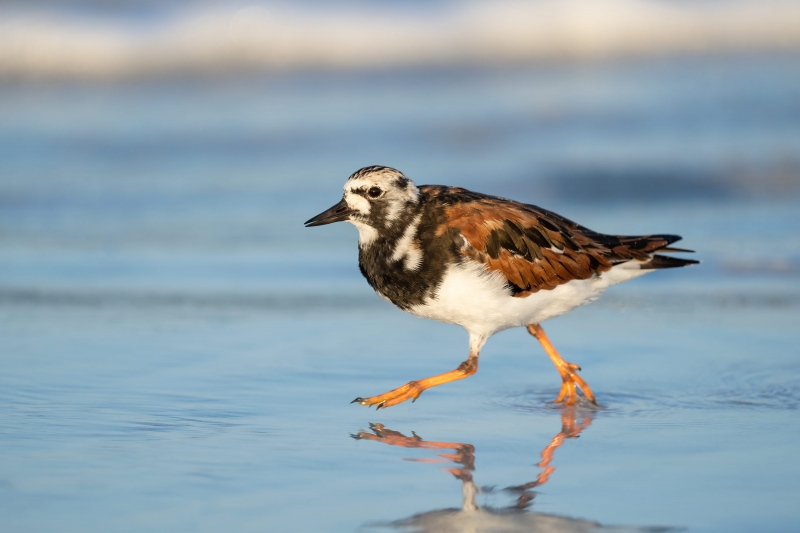
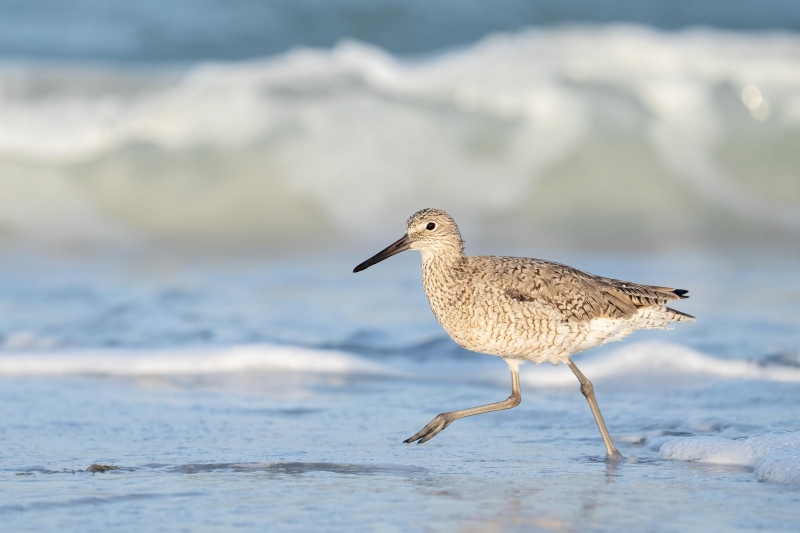
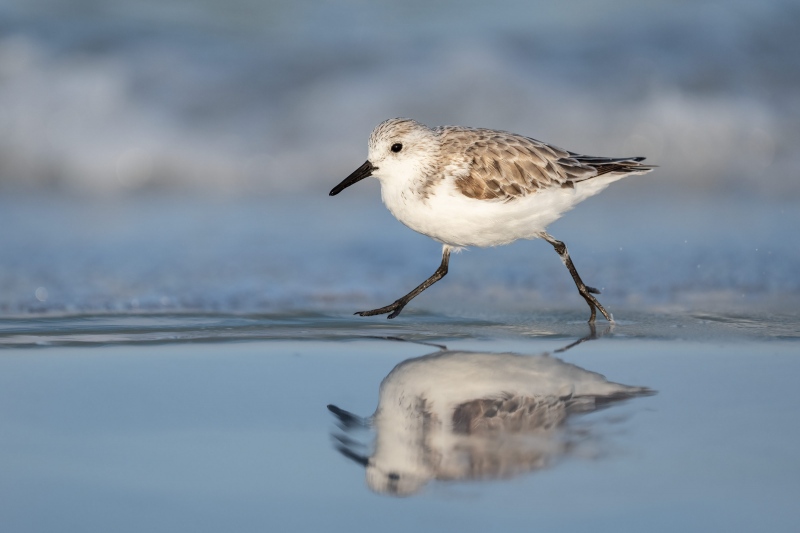
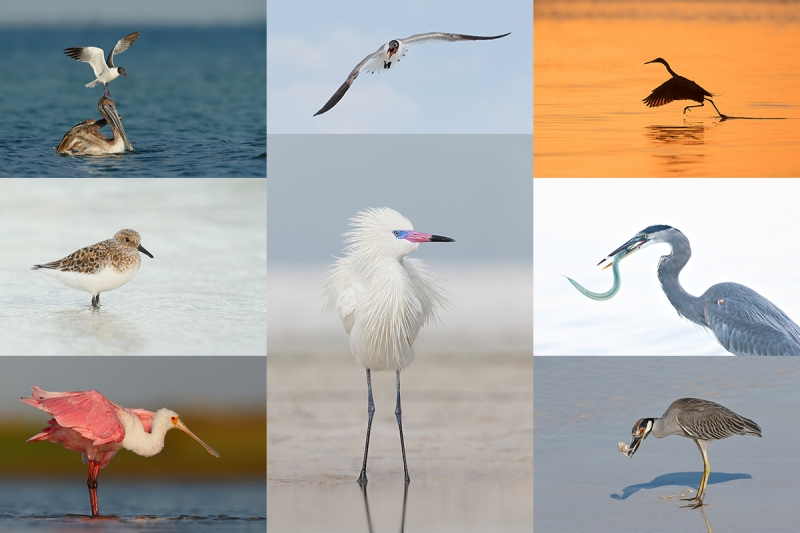
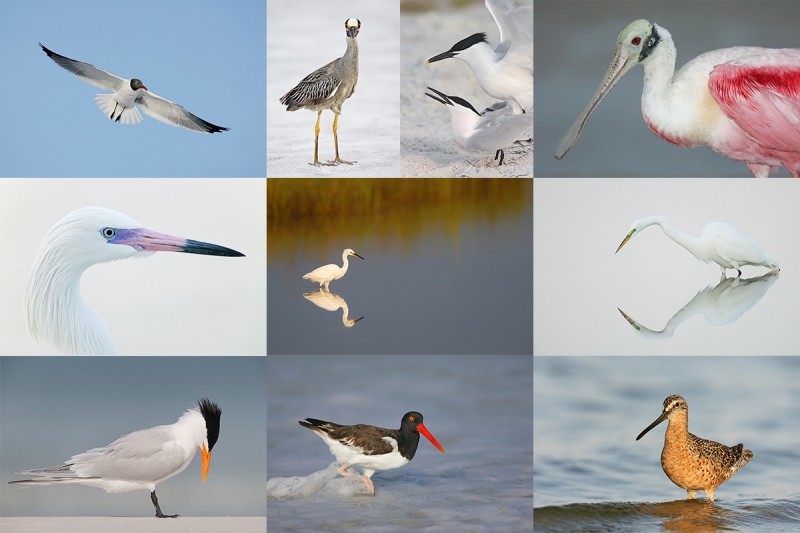
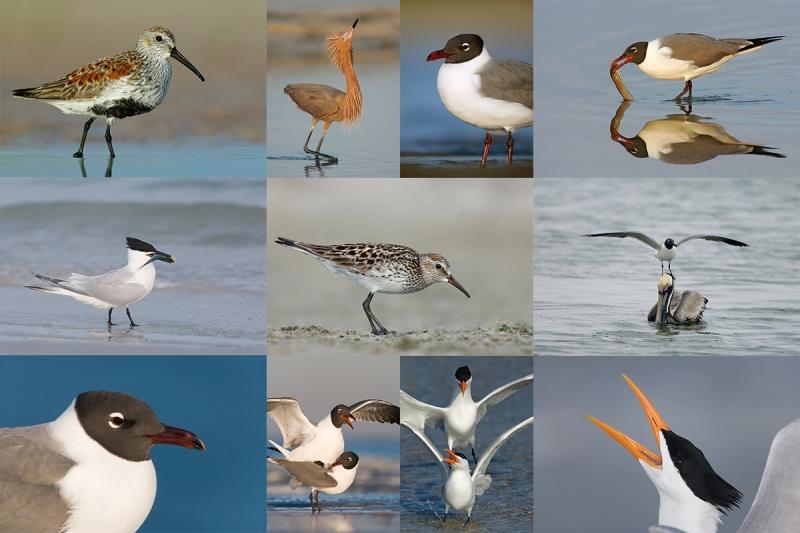
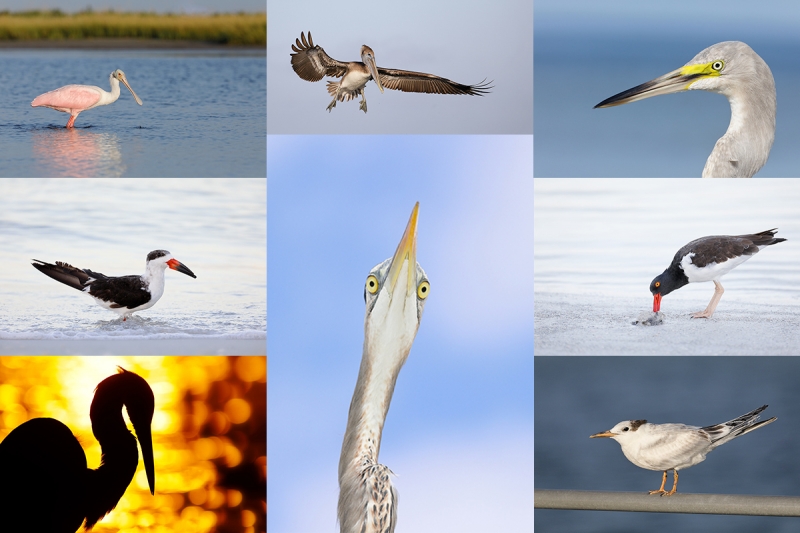













Why was I crouching when I created each of today’s featured images when I could have gotten lower by sitting? – In order to get the breaking waves behind the birds above thier heads and not intersecting with the birds.
Which of today’s three featured images is your favorite? Please leave a comment letting us know why you made your choice. – Sanderling (Image 3) because of the reflection.
Exposure Question
Why was the shutter speed for the Sanderling image (1/2500 second), 2/3-stop faster than the shutter speed for the turnstone and Willet images (1/1600 second)? – The sanderlings feathers are much brighter white, so you needed less light for exposure. (Also, I believe sanderlings are a little faster, so the speed may help a little…)
I think you were crouching because these little birds are fast and by crouching you can shift angle/position much much faster than if you are sitting. All beautiful, but I’m particularly fond of the sanderling. They are just so cute, and I love the reflection.
All three images Ruddy Turnstone and Willet and Sanderling on surf are interesting and well made photos!
The sanderling is not only a faster bird but also has more bright white so faster shutter to keep from overexposing the white. It’s my favorite of the three because of the full reflection showing speed.
Part B is the correct answer. The speed of the running bird does not affect the exposure.
a
Hi Artie,
1. Why crouch? As you mentioned in today’s blog, “the wet sand along the edge of the surf and/or gently breaking wavelets provide some of my favorite beach backgrounds”. If you were sitting using your ankle pod (as opposed to crouching), your background would contain a lot more sky.
2. Why was the shutter speed for the Sanderling image (1/2500 second), 2/3-stop faster than the shutter speed for the turnstone and Willet images (1/1600 second)?
The Sanderling is a darker bird. The camera will try to meter it to neutral grey by adding light. Manually increasing the shutter speed by 2/3 will compensate.
Hi Jordan,
Thanks for commenting. 1. is mostly incorrect.
2. I think that you meant that the Sanderling is brighter (not darker).
a
The image of the Willet because of the breaking wave
Artie
I like all 3 but my favorite is image #2 with the breaking wave BG. I do like the reflection in #1 & #3.
You crouched because you didn’t want to get your butt wet…. 🙂
Actually i think it would be that you wouldn’t see the reflections or in image #2 the breaking wave. The SS maybe because of the whites and the reflection in the Sanderling vs the Willet
Always with love b
Thanks, Bob. I like them all too. Nobody has figured out why I was crouching rather than sitting. It has to do with sun angle … My butt was already very wet. Two feet or so lower would not have affected the reflections very much. In fact, if you are lower I think that you get more foreground reflections … Yes to the brighter whites, no to the reflection.
much love and see you soon!
a